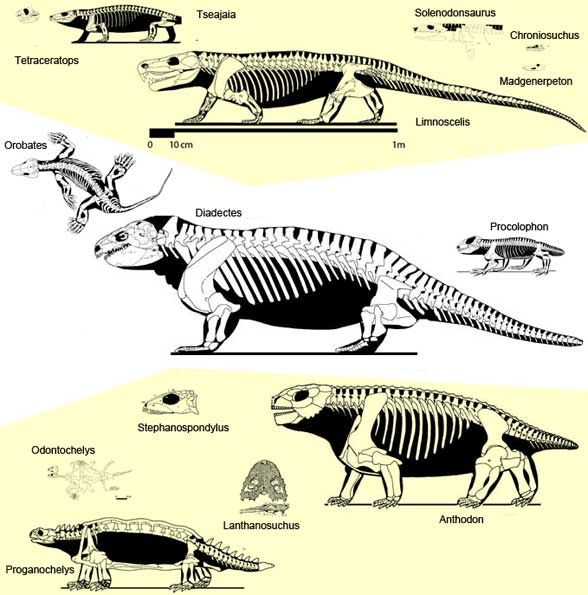From the abstract
“Corneous skin appendages are not only common and diverse in crown-group amniotes but also present in some modern amphibians.”
This goes against common knowledge. The San Diego Zoo webpage reports about caecilians, “Some have tiny, fishlike scales within the rings.” That doesn’t count. Zylberberg et al 1980 reported this originally.
“This raises the still unresolved question of whether the ability to form corneous skin appendages is an apomorphy of a common ancestor of amphibians and amniotes or evolved independently in both groups.”
The authors don’t realize caecilians are microsaurs, apart from frogs and salamanders.
“So far, there is no palaeontological contribution to the issue owing to the lack of keratin soft tissue preservation in Palaeozoic anamniotes. New data are provided by a recently discovered ichnofossil specimen from the early Permian of Poland that shows monospecific tetrapod footprints associated with a partial scaly body impression. The traces can be unambiguously attributed to diadectids and are interpreted as the globally first evidence of horned scales in tetrapods close to the origin of amniotes.
The authors don’t understand the origin of amniotes goes back another 40 million years to the Viséan with Silvanerpeton (Fig 1). Diadectes appears below (Fig 3).

Figure 1. Silvanerpeton from the Upper Viséan (331 mya) is the outgroup taxon for Gephyrostegus and the Amniota. This specimen needs a closer look for scales.
From the abstract
“Taking hitherto little-noticed scaly skin impressions of lepospondyl stem amniotes from the early Permian of Germany into account, the possibility has to be considered that the evolutionary origin of epidermal scales deeply roots among anamniotes.”

Figure 2. Westlothiana reconstructed. The gray area is the lumbar region expanded in a gravid female.
This can be confusing, but here’s a possible explanation.
(The paper is behind a paywall, so I’m guessing here). Among taxa traditionally considered within the Lepospondyli are several microsaurs and Westlothiana (Fig 2), an early archosauromorph reptile. Wikipedia reports, “Members of Westlothiana were heavily scaled, with thin scales on the belly and many rows of thick, overlapping scales on the back,”
Unfortunately the authors don’t realize that diadectids are reptiles and that ‘Amniota’ is a junior synonym of Reptilia according to the large reptile tree (LRT, 2319 taxa). This insight goes back to 2011 (link below). The nesting of Westlothiana as a reptile goes back to 2011.

Figure 3. Basal Diadectomorpha from 2011. This has not changed since then.
If a paleontologist wants headlines
they have to plant a ‘surprise’ element. Here Voigt et al rely on an out-dated hypothesis that considered diadectids to be pre-amniotes as the cornerstone of their paper. That makes the scaly belly skin of their diadectid a ‘surprise’ with phylogenetic implications.
It’s no surprise that diadectids had scales. They are and always were reptiles.
Klembara et al 2019
also moved diadectomorphs inside the Amniota. Add taxa to find this out for yourself.
References
Klembara J, Hain M, Ruta M, Berman DS, Pierce SE and Henrici AC 2019. Inner ear morphology of diadectomorphs and seymouriamorphs (Tetrapoda) uncovered by high-resolution x-ray microcomputed tomography, and the origin of the amniote crown group. Palaeontology (advance online publication) Future publication date: August 5, 2020
doi: https://doi.org/10.1111/pala.12448
Voigt S et al (7 co-authors) 2024. A diadectid skin impression and its implications for the evolutionary origin of epidermal scales. Biology Letters 20(5):
http://doi.org/10.1098/rsbl.2024.0041
Zylberberg L, Catanet J and De Ricqles A 1980. Structure of the dermal scales in gymnophiona. Journal of Morphology 165(1): abstract online
Diadectes is not an Amphibian. And Procolophon is a diadectid.
Publicity
IFLScience.com
Quoting the article: “A new fossil provides evidence they evolved in the Permian era, before the first major split in land-dwelling vertebrates’ family tree. Moreover, it provides clues allowing Voigt and co-authors to identify the maker of the prints as a diadectid, considered the ancestor of amniotes – a category including reptiles, mammals, and birds.”
No. According to the large reptile tree (LRT, 2319 taxa) Diadectids were amniotes and lepidosauromorphs close to Procolophon, bolosaurids and pareiasaurs (Fig 1). Amniota is a junior synonym of Reptilia. Silvanerpeton is the last common ancestor.
